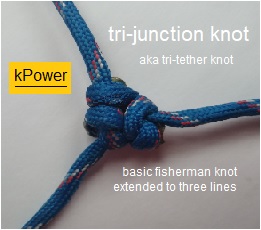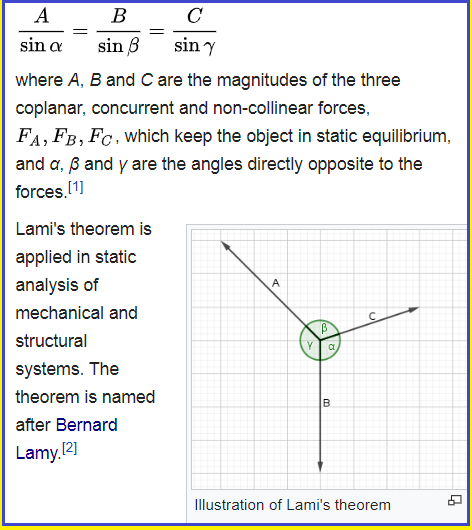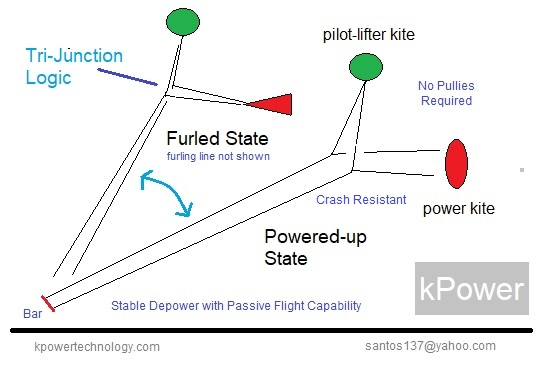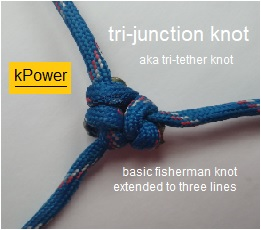Tri-Junction
Rigging
- 3r Iso-Wing Bench-top Demo video "This set-up flew passively with wind from any direction" "Other old demos validated tri-sail flight in fixed rigs. New combo demos will validate 3r tri-sails.
Crosslinked wings exhibit "aggregate stability", even when some wings transiently misbehave." ~ Dave Santos - v?
More notes, touching on points raised by your inspiring paper, summarizing related art and opinion-
- Two partial prior art tri-tether cases- vintage Zeppelin 3r anchoring patent and Tigner's AWE patent.
- Higher load velocity as key advantage of crosswind load trajectories like 3r, over 1r downwind reeling. Less transmission machinery is needed to gain high angular shaft velocity.
- Tether drag almost negligible with large slow power kites, after all 4 lines is the kitesport and PG standard. High L/D wings are far more tether-drag limited. 3r multi-lines can be thinner than 1r and still more resistant to runaway.
- Optimal to maintain max working load of kite (~2x safety factor), not, eg., rated human load (~8x safety factor). Elastic aft bridling dumps excess load like a shock absorber.
- UHMWPE and Nylon return most of their elastic energy when tensioned-untensioned. Elasticity is more of a dynamics issue than a source of loss, in normally proportioned rigs.
- No hills or towers really needed; turf-grass/hay is a fine surface that does not degrade kites, and the hay is an extra carbon-crop. A large dragged kite actually floats over grass, as a fluidized bed. An elevated 3r bridlepoint invites a looping foul of the kite around the downwind leg. The kite can be moved about and launched from a wheeled trolley. Good passive-control kites want to fly, and take off readily. "Kitekillers" are a means to avoid landing uncertainties.
- AWE is "sailing in the sky", still requiring skilled human labor to be productive. Full automation of large AWES is a distant hope, but a kPower looping foil under a pilot kite kite has run all-modes for two weeks, since the sled pilot kite always self relaunched after lulls. The outdoors is simply too dynamic and not structured enough for industrial automation. FAA requires Pilot-In-Command and Visual-Observer. Supervisory automation is the sweet-spot.
- Three lines form a rigger's triangle, a mechanical advantage transmission. A bowstring and arrow act similarly to what a tri-tether can do.
- Macroscopic application of QM methods is called "analog QM", to distinguish from microscopic QM. As such, there are fine similarity cases, like Yves Crouder et al, with walking-drop experimental model. De Broglie-Bohm Mechanics is now applied in economics, sociology, and other fields.
- Single-skin kites may ultimately dominate by both cost and power-to-mass, at slightly lower L/D. SS progress is revolutionary in PGs and power kites. The NASA Power Wing remains a potent wing, popular with DE kite-skateboarders. These kites must stay on a trajectory surface, since they do not glide back fast like a hot kiteplane.
- Control Theory is another useful analytical lens. Conventional AWE control theory presumes algorythmic digital control with sensing and actualtion. Classic kite passive dynamic stability of equivalent functionality is far more elegant classical cybernetics (Gauss saw toys as profound mathematical objects). Active digital control can be dedicated to supervisory override, exception-handling, mode transitions, active tuning, etc. Passive control is an embodied-logic analog computing case, even a quantum computing analog where DOF states embody qubits.
- Standing Lattice waves are Faraday Waves. Acoustics, heat, and mechanical action are all phonon waves under scale invariance. Lots of applicable wave science in in disciplinary silos. Classical harmonic analysis and resonance are key kite attributes. Synchrony emerges naturally from periodic order of spring-mass units.
- A cool AWE scicomp project would be a dynamic simulation environment hosting endless promising combinations of kite/tether/wind/load, assessed in real time. An ultimate AWE scicomp concept could consist of public global wind geodata overlaid with load demand-interface geodata, supporting global AWES infrastructure simulation, an engineering basis for solving the global clean energy gap with kites.
- KiteLab 3r demos played out the pulleys from the anchor points to match wind direction and kite angle to fixed center generator. Lowest part count and simplest cheapest parts drove transmission design.
Hope something here helps,
dave
Tri-Tether Note: Belay Function
Large kite arches need to rotate with changes in wind direction. The simplest method is belay between anchors in a circle. A tri-tether at either end of the arch is workable. Two legs of the tri-junction maintain tension while the slack third leg is set at the new anchor-point. Tension is than transferred to the new leg, leaving the old anchor leg slack.
This method is well known already but worth repeating in the context of all tri-tether methods. Once again, the tri-tether is shown effective. In String-Net terms, the slack leg moves with effective "zero-energy." Anchor belay is not truly a primitive method but a powerful advanced solution. Similar belay ideas are even proposed for phonon-based quantum computing to dynamically reconfigure topological order.
Tri-Tether Analogue Transistor-Modes
Thick polymer line as primary load-path, with secondary side-line controlling power transmission. Primary load-path set slack to begin with. Static or dynamic force within slack-length cannot pass. Secondary sideline pulls the slack out and may "latch" (tie-off) in switch-mode or vary in amp mode. With slack taken out, force then transfers via primary load-path (tin-can telephone corner-node). Basic transistor variants and logic gates are simple elaborations of tri-tether mechanisms.
A MOSFET analogue is a 3D "prismatic" ribbon-based (belted) tri-tether, for parallel power.
Lami's Theorem on Tri-tether Forces, a new knot, plus QM Analogues galore
First, yet another nice third-party fit to kite analogue QM problem domains; our empirically modified Bohmian kite interpretation fits nicely here:
https://arxiv.org/pdf/2002.08147.pdf

Then, JoeF and I have identified fundamental Tri-Tether math-
Lami's Theorem wiki [partial screen clip below]

DynamLami's Theorem wiki [partial screen clip below]

Here is a Lami-related higher topological dimensioned math approximating a tethered sail, our crystal unit-cells: Tutte embedding
Tri-Junction Pilot-Lifted Power Kite

"Sling Angle" formula and look-up charts (Tri-junction Rigging)
- Lifting Sling Load and Angle Calculator
- SlingAnglesGENERALimages
- Rigging Calculator
- GENERAL OSHA AND MANUFACTURER REQUIREMENTS FOR ALL SLINGS
A rig of 0 deg is an infinite singularity.
======================================
High-Symmetry Tri-Junction Knot
Tri-radial rotation symmetry, slight planar asymmetry. Easy to tie, strong, not too bulky.


Women know the Fisherman's Knot as the Magic Knot of knitting and crochet. Same knot, different gender.
Therefore "Triple Magic-Knot" is a suited tag. Its sorcery when dudes use it.
===========================
Looking for higher line-count symmetric knots.
Eureka, maybe. A six-leg (three axis) version simply by extending the three Triple Magic Knot cut-off tails into three added long-lines.
Been looking for such a symmetric six-junction knot for years. There's always been some flaw. We'll see how this one pans out. Tetrahedra nodes are another family of high interest.
IMAGE2NOTABLETOUSESHUTTERCOCKFINDEQUIVALENTNETTINGKNOT
Sloppy knots may get the job done, but a fine knot is a gem.
================
Tri-junction brake for three-line kite with two hand-straps
Making sure this tri-tether idea, mentioned before, gets a post in context of Eureka Rig, itself a tri-tether case. Its a Double Whammy.
The 2.0 PL SS Uniq kite used for the Eureka Rig is sold as a three-line kite with bar. I used that bar elsewhere long ago, and rigged two straps with a tri-junction (tri-tether) for the brake line a couple of years ago. When I spread my arms wide, the tri-junction pulls the brake-line enough to reverse flight. This has proven natural and effective, however, with a larger kite, in strong winds, it will take a lot of strength to spread arms, so this solution is mostly for small kites. Its a good upgrade to many two-line kites with straps, to make them three-line. Its also a kite-killer approach.
Therefore, the Eureka prototype actually has 4 tri-junctions, counting the brake-function junction (rhyming term of art) at the straps.
Open-AWE_IP-Cloud